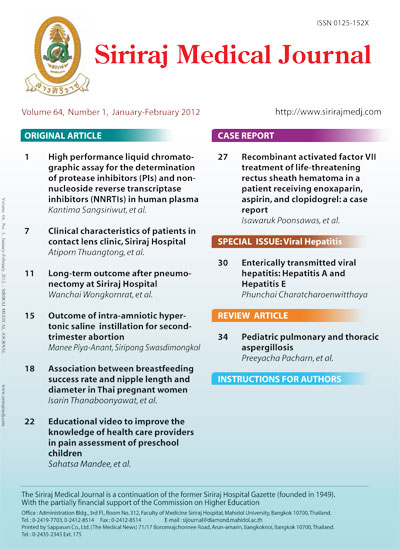Medical Services during the 24th Summer Universiade
Keywords:
Sports injury; Universiade; World University Games; mass gatherings; medical serviceAbstract
Background: International sports competitions are one of the mass gathering events which require a well-planned medical care system for large numbers of participants. The Universiade, the World University Games, is organized for university athletes every two years.
Methods: The medical service organization was presented and the medical care for injuries and illnesses provided during the 24th Summer Universiade were described.
Results: During 1 to 23 August 2007, a total of 5,641 patients aged 12-89 years (including 1,700 athletes) received medical care. There were 2,535 cases (44.9%) using the Athletesั Village Polyclinic, 2,755 cases (48.8%) using the on-site medical units, and 351 cases (6.2%) using Thammasat Hospital. For the patients presented at the Athletesั Village Polyclinic, muscle
strain was the most common injury (n=287, 34.1%), and musculoskeletal system problems were the most common illnesses (n= 484, 27.33%). Nineteen patients required hospital admission at Thammasat Hospital.
Conclusion: This information might be useful for planning medical services in international multi-sport competitions in the future.
References
2. Grange JT. Planning for large events. Curr Sports Med Rep. 2002 Jun;1(3):156-61.
3. Athanasopoulos S, Kapreli E, Tsakoniti A, Karatsolis K, Diamantopoulos K, Kalampakas K, et al. The 2004 Olympic Games: Physiotherapy services in the Olympic Village polyclinic. Br J Sports Med. 2007 Sep;41(9):603-9.
4. Wetterhall SF, Coulombier DM, Herndon JM, Zaza S, Cantwell JD. Medical care delivery at the 1996 Olympic Games. Centers for Disease Control and Prevention Olympics Surveillance Unit. JAMA. 1998 May13;279(18):1463-8.
5. Eaton SB, Woodfin BA, Askew JL, Morrisey BM, Elsas LJ, Shoop JL, et al. The Polyclinic at the 1996 Atlanta Olympic Village. Med J Aust.1997 Dec 1-15;167(11-12):599-602.
Downloads
Published
How to Cite
Issue
Section
License
Authors who publish with this journal agree to the following conditions:
Copyright Transfer
In submitting a manuscript, the authors acknowledge that the work will become the copyrighted property of Siriraj Medical Journal upon publication.
License
Articles are licensed under a Creative Commons Attribution-NonCommercial-NoDerivatives 4.0 International License (CC BY-NC-ND 4.0). This license allows for the sharing of the work for non-commercial purposes with proper attribution to the authors and the journal. However, it does not permit modifications or the creation of derivative works.
Sharing and Access
Authors are encouraged to share their article on their personal or institutional websites and through other non-commercial platforms. Doing so can increase readership and citations.











